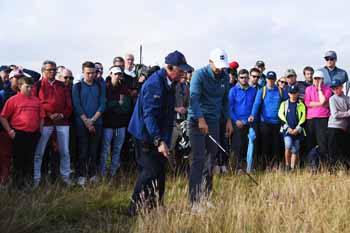The rules of golf: Relief from movable or immovable obstructions
Shona McRae, Assistant Director – Rules, The R&A, looks at the refereeing decisions that were made at the 147th Open Championship at Carnoustie last month.
For the 147th Open Championship at Carnoustie, an international team of referees was assembled from 30 different organisations from around the world to deal with any Rules matters. The team handled nearly 400 rulings over the course of the four days of the championship – an average of two rulings per group per round.
With a field of 156 golfers, having a walking referee with every group is very beneficial and helps with the speed of play if rulings can be dealt with swiftly. However, despite the large number of rulings, the reality is that the majority of incidents dealt with on course tend to be the common Rules problems which come up time after time rather than the weird or wonderful.

Tiger Woods during the final round of the Open Championship at Carnoustie Golf Club. R&A via Getty Images
The most common ruling requested during the week was for relief from movable or immovable obstructions. Players wanted to ensure that they got the procedure right and would call on the referee to oversee the relief from a sprinkler head or dropping the ball if it landed in a spectator’s bag. These types of rulings occurred over 70 times throughout the week.
With the huge infrastructure that was in place to cater for the 172,000 spectators at Carnoustie, inevitably grandstands, TV towers, food outlets and tents came into play and the team of referees gave 48 rulings involving these temporary immovable obstructions during the championship. As these structures are not part of the challenge of the golf course, the Local Rule for temporary immovable obstructions provides line of sight relief should a player’s ball finish in or behind one of these structures.
Of course, the Barry Burn also featured prominently during the championship and a number of rulings giving relief from the water hazard were delivered. Another of the courses attributes, Carnoustie’s putting greens also proved to be challenging in terms of the Rules. The pristine condition of the turf and its surrounds required referees to determine if the ball was on or off the putting green on a regular basis, and this accounted for a large number of rulings over the course of the week.

Jordan Spieth discusses a ruling with a referee on the 12th hole during round two of the Open Championship at Carnoustie Golf Club on July 20, 2018 in Carnoustie. (Photo by Richard Heathcote/R&A/R&A via Getty Images)
Carnoustie also has a double green on the course (4th and 14th) measuring nearly 80 yards long. When playing the 4th hole during the third round, Thomas Pieters found himself on the back portion of the green a considerable distance away from hole. As it is a double green, he was not on a wrong putting green and had to play the ball as it lied.
Pieters decided that the best shot was to chip the ball rather than putt and asked the referee if he would be allowed to use a club other than his putter. The Rules of Golf do not require a player to use a putter on the green, just that the ball must be fairly struck with the head of a club (Rule 14-1a). Therefore, the referee confirmed that Pieters was permitted to use an iron to chip the ball and that he would still need to have the flagstick attended as he was on the green and must not strike the flagstick in the hole, unattended, when the stroke has been made on the putting green (Rule 17-3).
Although this is permissible under the Rules, it has the potential to make golfers very unpopular with the greenstaff! However, with a level of precision that would be the envy of most golfers, Pieters was able to play the shot skilfully without damaging the putting green.

Shona McRae
To find out more about the Rules of Golf, visit www.randa.org/Rules















Let me tell You a sad story ! There are no comments yet, but You can be first one to comment this article.
Write a comment